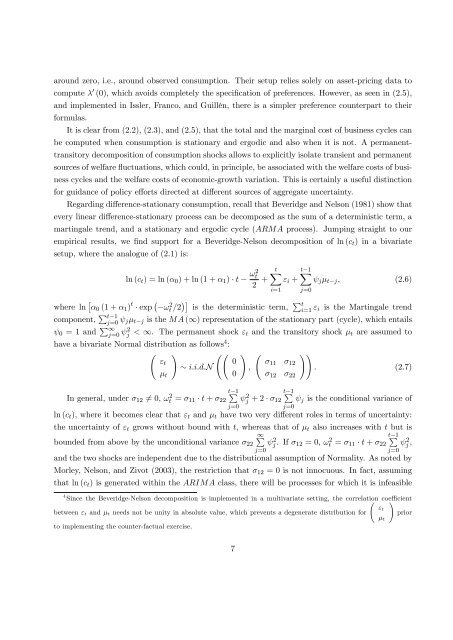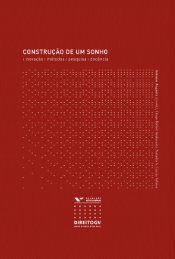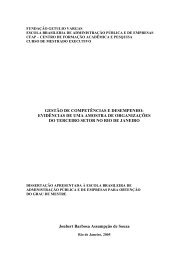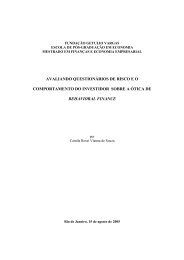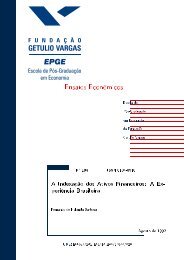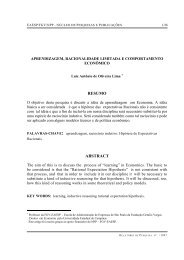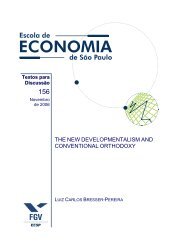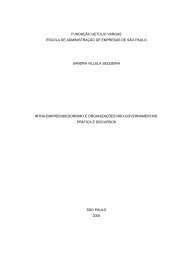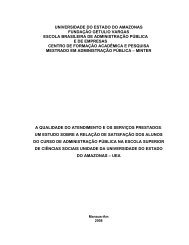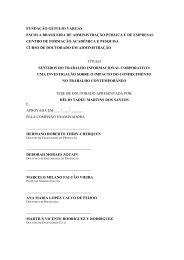Ensaios Econômicos - Sistema de Bibliotecas da FGV - Fundação ...
Ensaios Econômicos - Sistema de Bibliotecas da FGV - Fundação ...
Ensaios Econômicos - Sistema de Bibliotecas da FGV - Fundação ...
You also want an ePaper? Increase the reach of your titles
YUMPU automatically turns print PDFs into web optimized ePapers that Google loves.
around zero, i.e., around observed consumption. Their setup relies solely on asset-pricing <strong>da</strong>ta to<br />
compute 0 (0), which avoids completely the speci…cation of preferences. However, as seen in (2.5),<br />
and implemented in Issler, Franco, and Guillén, there is a simpler preference counterpart to their<br />
formulas.<br />
It is clear from (2.2), (2.3), and (2.5), that the total and the marginal cost of business cycles can<br />
be computed when consumption is stationary and ergodic and also when it is not. A permanenttransitory<br />
<strong>de</strong>composition of consumption shocks allows to explicitly isolate transient and permanent<br />
sources of welfare ‡uctuations, which could, in principle, be associated with the welfare costs of business<br />
cycles and the welfare costs of economic-growth variation. This is certainly a useful distinction<br />
for gui<strong>da</strong>nce of policy e¤orts directed at di¤erent sources of aggregate uncertainty.<br />
Regarding di¤erence-stationary consumption, recall that Beveridge and Nelson (1981) show that<br />
every linear di¤erence-stationary process can be <strong>de</strong>composed as the sum of a <strong>de</strong>terministic term, a<br />
martingale trend, and a stationary and ergodic cycle (ARMA process). Jumping straight to our<br />
empirical results, we …nd support for a Beveridge-Nelson <strong>de</strong>composition of ln (c t ) in a bivariate<br />
setup, where the analogue of (2.1) is:<br />
ln (c t ) = ln ( 0 ) + ln (1 + 1 ) t<br />
tX<br />
2 + Xt 1<br />
" i +<br />
! 2 t<br />
i=1<br />
j=0<br />
j t j ; (2.6)<br />
where ln 0 (1 + 1 ) t exp ! t 2 =2 is the <strong>de</strong>terministic term, P t<br />
i=1 " i is the Martingale trend<br />
component, P t 1<br />
j=0 j t j is the MA (1) representation of the stationary part (cycle), which entails<br />
0 = 1 and P 1<br />
j=0 j 2 < 1. The permanent shock " t and the transitory shock t are assumed to<br />
have a bivariate Normal distribution as follows 4 :<br />
!<br />
" t<br />
i:i:d:N<br />
t<br />
In general, un<strong>de</strong>r 12 6= 0, ! t 2 tP<br />
1<br />
= 11 t + 22<br />
0<br />
0<br />
j=0<br />
!<br />
2<br />
;<br />
j + 2 12<br />
!!<br />
11 12<br />
: (2.7)<br />
12 22<br />
tP<br />
1<br />
j=0<br />
j is the conditional variance of<br />
ln (c t ), where it becomes clear that " t and t have two very di¤erent roles in terms of uncertainty:<br />
the uncertainty of " t grows without bound with t, whereas that of t also increases with t but is<br />
1P<br />
boun<strong>de</strong>d from above by the unconditional variance <br />
2 22 j . If 12 = 0, ! t 2 tP<br />
1<br />
= 11 t + <br />
2 22 j ,<br />
and the two shocks are in<strong>de</strong>pen<strong>de</strong>nt due to the distributional assumption of Normality. As noted by<br />
Morley, Nelson, and Zivot (2003), the restriction that 12 = 0 is not innocuous. In fact, assuming<br />
that ln (c t ) is generated within the ARIMA class, there will be processes for which it is infeasible<br />
4 Since the Beveridge-Nelson <strong>de</strong>composition is implemented in a multivariate setting, the correlation coe¢ ! cient<br />
" t<br />
between " t and t needs not be unity in absolute value, which prevents a <strong>de</strong>generate distribution for prior<br />
t<br />
to implementing the counter-factual exercise.<br />
j=0<br />
j=0<br />
7


